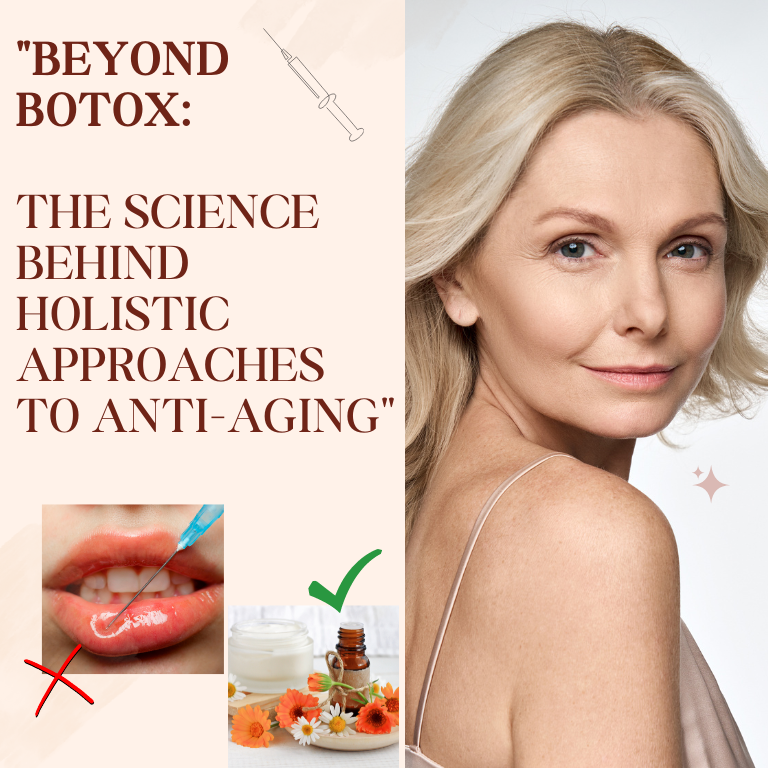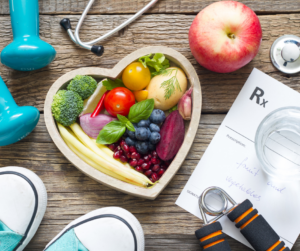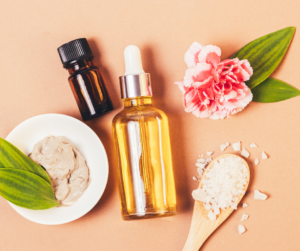
“Beyond Botox: The Science Behind Holistic Approaches to Anti-Aging”
Aging is a natural part of life that we all must face. As we age, our bodies undergo physical and mental changes that can affect our overall wellbeing. While aging is a natural process, many of us may find ourselves searching for ways to slow down or even reverse the aging process.
One popular solution for addressing signs of aging is Botox, a cosmetic injection that temporarily paralyzes the muscles that cause wrinkles and fine lines.
In 2020, plastic surgeons administered over 6.2 million injections of Botulinum toxin, making it the top nonsurgical cosmetic procedure worldwide. Following closely behind were hyaluronic acid and hair removal, which ranked as the second and third most commonly performed nonsurgical cosmetic procedures globally.
While Botox may seem like a quick fix, it’s important to remember that it comes with potential risks and side effects, and it is not the solution for aging gracefully.
What is Botox?

Botox is a brand name for a type of botulinum toxin, which is a neurotoxin that can temporarily paralyze muscles. It is commonly used for cosmetic purposes to reduce the appearance of wrinkles and fine lines, but it also has medical applications, such as treating migraines and muscle spasms.
Botox works by blocking the release of a neurotransmitter called acetylcholine, which is involved in the communication between nerves and muscles. By preventing the release of acetylcholine, Botox can temporarily paralyze the muscles that it is injected into.
While Botox may have some effects on brain chemistry, such as reducing muscle tension and relieving pain, there is currently no evidence to suggest that it directly alters brain chemistry beyond its effects on the muscles. However, some studies have suggested that Botox injections may affect emotional processing by reducing the ability to interpret facial expressions and may also affect social cognition.
Let’s look at the history of Botox & its cosmetic use:
Botulinum toxins are extremely potent poisons that can be lethal in very small doses. They belong to a family of naturally occurring neurotoxins that are produced by the bacteria Clostridium botulinum. There are seven different types of botulinum toxin, but type A is the most potent and widely used for therapeutic and cosmetic purposes.
The therapeutic use of botulinum toxin dates back to the early 19th century when Justinus Andreas Christian Kerner first observed its effect on skeletal muscles and parasympathetic function. Since then, its indications have expanded significantly, and it has been approved by the FDA for various medical and cosmetic purposes.
For instance, botulinum toxin was approved for the treatment of strabismus in 1979, followed by the approval for hemifacial spasm, blepharospasm, and cervical dystonia. In 1990, it was recognized by the National Institutes of Health Consensus Conference as a safe and effective therapy for adductor spasmodic dysphonia, oromandibular dystonia, and cervical dystonia. Botulinum toxin has also been approved for the treatment of achalasia and primary axillary hyperhidrosis.
Moreover, since its approval for cosmetic purposes in 2002, botulinum toxin type A injections have become one of the most common cosmetic procedures performed worldwide. However, the use of botulinum toxin for facial lines other than glabellar wrinkles is considered an off-label use. Besides, there are other off-label uses of botulinum toxin, including Meige’s syndrome, sphincter dysfunction, and migraine headaches, as well as tremor disorders, juvenile cerebral palsy, and other spasticity disorders.
Understanding the Potential Risks and Side Effects of Botox Injections

Botox, or botulinum toxin, is a popular cosmetic treatment that works by relaxing the muscles that cause wrinkles and fine lines. While it may produce visible results, it is important to be aware of its potential side effects and limitations.
One important factor to consider is that Botox is a temporary solution to the appearance of wrinkles and fine lines. The effects of Botox usually last for a few months, after which the injections must be repeated to maintain the results. Additionally, Botox only addresses one aspect of aging and does not address other factors that contribute to the aging process, such as skin elasticity, pigmentation changes, and changes in bone structure.
Botox also comes with potential risks and side effects. One of the most common side effects of Botox is temporary muscle weakness or paralysis. This can occur when the toxin spreads beyond the injection site and affects nearby muscles. As a result, individuals may experience difficulty speaking or swallowing, drooping eyelids, or a lopsided smile. Other side effects of Botox may include headaches, flu-like symptoms, and bruising or swelling at the injection site. Some people may also experience dry mouth, fatigue, or respiratory infections.
While these side effects are generally mild and temporary, there have been reports of more serious complications, such as anaphylaxis (a severe allergic reaction) or botulism (a rare but serious illness caused by the toxin). It is important to carefully weigh the potential risks and benefits of Botox and seek treatment from a qualified and experienced practitioner who can ensure your safety and provide appropriate aftercare.
For those seeking a more holistic approach to anti-aging, there are a variety of natural and non-invasive alternatives to Botox. These options may not produce immediate results, but they can help improve the health and appearance of the skin over time, without the potential risks and side effects associated with Botox. Examples of natural and non-invasive alternatives to Botox include facial exercises, acupressure, and nutrient-rich skincare products.
Holistic Approaches to Aging Gracefully
While Botox may seem like a quick fix for addressing signs of aging, there are other, more holistic approaches to aging gracefully that can help you maintain your physical and mental wellbeing as you age.
These approaches include:
- Adopting a healthy lifestyle:
 Adopting a healthy lifestyle is crucial for maintaining youthfulness and promoting healthy aging. This includes eating a balanced diet, exercising regularly, getting enough sleep, reducing stress levels, and avoiding harmful substances like tobacco and excessive alcohol consumption. By doing so, you can maintain healthy skin, hair, and nails and prevent premature aging.
Adopting a healthy lifestyle is crucial for maintaining youthfulness and promoting healthy aging. This includes eating a balanced diet, exercising regularly, getting enough sleep, reducing stress levels, and avoiding harmful substances like tobacco and excessive alcohol consumption. By doing so, you can maintain healthy skin, hair, and nails and prevent premature aging. - Using Natural Skincare products:
 Using high-quality skincare products that are appropriate for your skin type and age can help you maintain healthy and youthful-looking skin. Skincare products can help address common skin concerns, such as dryness, dark spots, and uneven texture. Natural skincare products can help address common skin concerns such as dryness, dark spots, and uneven texture. For dryness, argan oil, jojoba oil, and shea butter can help to hydrate the skin and improve its texture profoundly. Vitamin C, licorice root extract, and kojic acid can be effective in brightening the skin and fade dark spots. Alpha-hydroxy acids (AHAs) such as glycolic acid and lactic acid can help to exfoliate the skin and improve its texture, while tea tree oil, witch hazel, and aloe vera can help to soothe inflammation and prevent breakouts for acne-prone skin. When shopping for natural skincare products, look for those that are free of harsh chemicals, synthetic fragrances, and other potentially harmful ingredients. Instead, choose products that contain natural, plant-based ingredients that have been shown to be effective for your specific skin concern.
Using high-quality skincare products that are appropriate for your skin type and age can help you maintain healthy and youthful-looking skin. Skincare products can help address common skin concerns, such as dryness, dark spots, and uneven texture. Natural skincare products can help address common skin concerns such as dryness, dark spots, and uneven texture. For dryness, argan oil, jojoba oil, and shea butter can help to hydrate the skin and improve its texture profoundly. Vitamin C, licorice root extract, and kojic acid can be effective in brightening the skin and fade dark spots. Alpha-hydroxy acids (AHAs) such as glycolic acid and lactic acid can help to exfoliate the skin and improve its texture, while tea tree oil, witch hazel, and aloe vera can help to soothe inflammation and prevent breakouts for acne-prone skin. When shopping for natural skincare products, look for those that are free of harsh chemicals, synthetic fragrances, and other potentially harmful ingredients. Instead, choose products that contain natural, plant-based ingredients that have been shown to be effective for your specific skin concern. - Practicing self-care: Taking time for yourself, engaging in hobbies and activities that bring you joy, and managing stress can help you maintain your mental and emotional wellbeing as you age. Self-care can also help you feel confident and positive about yourself and your aging journey.
- Seeking professional advice: Consulting with a qualified medical professional can help you identify any health concerns and develop a plan for maintaining your overall health and wellbeing. Regular check-ups and screenings can help detect health issues early on, allowing for timely interventions and treatment.
- Incorporating herbs: Certain herbs are known for their anti-aging and skin-healing properties. These herbs can be incorporated into your diet or taken as supplements. Some examples of skin-healing herbs include:
- Turmeric: This golden spice is known for its anti-inflammatory properties and can help improve skin texture and reduce the appearance of wrinkles.
- Gotu kola: This herb is rich in antioxidants and can help improve circulation, which in turn can help reduce the appearance of fine lines and wrinkles.
- Ginseng: This adaptogenic herb can help reduce inflammation and improve skin elasticity, making it a popular ingredient in many skincare products.
Facial exercises and acupressure are two effective natural and non-invasive methods for reducing signs of aging.
A study conducted in 2018 found that facial exercises can significantly improve skin elasticity, resulting in a 32% increase in firmness after 20 weeks of consistent practice. This technique involves performing specific movements with the face, such as puffing out the cheeks or making exaggerated facial expressions, which help to strengthen the underlying muscles and promote blood flow.
Acupressure, on the other hand, involves applying pressure to specific points on the face and body, which can help to stimulate circulation, promote lymphatic drainage, and reduce tension in the muscles. A study published in the Journal of Clinical and Aesthetic Dermatology in 2015 found that acupressure was effective in reducing fine lines and wrinkles by up to 27% after just one month of use.
While the results of facial exercises and acupressure may take longer to become visible compared to cosmetic treatments such as Botox, they offer a more holistic approach to anti-aging that can provide long-lasting benefits without the potential risks and side effects associated with injectables. Additionally, these methods can be performed at home, making them accessible and cost-effective for anyone looking to improve the health and appearance of their skin.
Choosing Holistic Approaches Over Botox
While Botox may seem like an easy solution for addressing signs of aging, it’s important to remember that it comes with potential risks and side effects and is not the solution for aging gracefully.
Choosing a holistic approach to skincare over Botox can offer a wide range of benefits that go beyond just improving the appearance of the skin. While Botox injections may provide an immediate solution for fine lines and wrinkles, a holistic approach takes a more comprehensive and sustainable approach to skincare by focusing on promoting overall health and wellbeing.
By adopting healthy habits such as eating a balanced diet, staying hydrated, getting enough sleep, and managing stress, you can nourish your skin from the inside out. A diet rich in antioxidants, healthy fats, and vitamins can help to protect your skin from damage caused by environmental factors such as UV radiation and pollution while staying hydrated can help to keep your skin plump and radiant. Getting enough restful sleep can also help to reduce inflammation and promote cell turnover, leading to a more youthful and revitalized appearance.
In addition to adopting healthy habits, incorporating natural skincare products into your routine can help further improve your skin’s health and appearance. Products containing natural, plant-based ingredients like botanical oils, herbal extracts, and vitamins can help to nourish and protect the skin, while non-invasive treatments such as facial massages, gua sha, and acupuncture can help to stimulate collagen production and improve the skin’s texture.
By choosing a holistic approach to skincare, you can enjoy the benefits of a healthier and more radiant complexion without the risks and side effects associated with Botox. Additionally, focusing on your overall health and wellbeing can improve your quality of life in numerous ways, leading to a happier, more fulfilled life.
Thank you for reading today’s blog.
If you found it informative and helpful, please consider liking and sharing it with others who may benefit from this information. Also, make sure to subscribe to my blog for more updates and insights on holistic health and wellness.
If you are struggling with any chronic skin issue, I am here to help you. As a holistic practitioner, I offer a natural and comprehensive approach to healing, focused on improving your overall health and strengthening your immune system.
If you are interested in learning more, I invite you to schedule a discovery consultation with me by emailing contact@holisticskinwellness.com. Together, we can create a personalized plan to help you achieve healthy, clear skin.
References:
https://pubmed.ncbi.nlm.nih.gov/16112345/
https://www.karger.com/Article/FullText/370245#ref2
https://pubmed.ncbi.nlm.nih.gov/25613637/
https://www.ncbi.nlm.nih.gov/pmc/articles/PMC7874868/
https://pubmed.ncbi.nlm.nih.gov/33128076/
